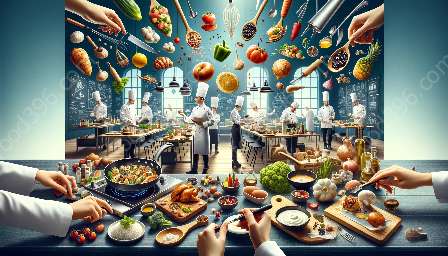Food sensory evaluation is a multifaceted process that involves the examination of food using the senses to understand its various attributes. This essential practice is pivotal in the realms of gastronomy, food science, and culinary training, shaping the way we perceive, analyze, and appreciate food.
Gastronomy and Food Sensory Evaluation
Gastronomy, the art and science of good eating, encompasses the study of food and culture, as well as the sensory experiences associated with food consumption. Food sensory evaluation plays a fundamental role in gastronomy by helping individuals understand and assess the quality, flavor, texture, and overall appeal of different food items. Whether it's evaluating the aroma of a fine wine or discerning the intricate flavors of a complex dish, sensory evaluation allows gastronomers to delve deeper into the nuances of food, broadening their appreciation for culinary delights.
Food Science and Sensory Evaluation
From a food science perspective, sensory evaluation serves as a crucial tool for analyzing and improving food products. By employing sensory testing methods, food scientists can gather valuable data on consumer preferences, product acceptability, and potential areas for product enhancement. Sensory evaluations also aid in understanding the impact of various factors such as processing techniques, ingredient compositions, and storage conditions on the sensory attributes of food. Through sensory analysis, food scientists can optimize the sensory properties of food products, ensuring that they align with consumer expectations and preferences.
Culinary Training and Sensory Perception
For individuals undergoing culinary training, developing a keen sense of sensory perception is indispensable. The ability to discern and evaluate the sensory attributes of ingredients and dishes is a hallmark of culinary expertise. Aspiring chefs learn to utilize their senses to assess the freshness, flavor, and texture of ingredients, as well as to refine their palate for creating harmonious flavor combinations. They also become adept at employing sensory evaluation techniques to maintain quality standards in food preparation and to continuously improve their culinary creations.
The Art of Sensory Evaluation
Conducting sensory evaluations involves a systematic approach that encompasses multiple sensory modalities, including taste, smell, sight, touch, and sometimes, sound. This holistic examination enables comprehensive understanding and assessment of food products. The process often involves trained sensory panelists or consumers who participate in blind taste tests, aroma profiling, texture analysis, and overall sensory profiling of food items. Through these evaluations, detailed sensory profiles are developed, shedding light on the intricacies of flavor, aroma, appearance, and mouthfeel.
Enhancing the Food Experience
Food sensory evaluation not only benefits professionals in gastronomy, food science, and culinary arts but also enriches the experience of food enthusiasts. Whether through wine tastings, food pairings, or interactive culinary experiences, individuals can develop a deeper appreciation for the sensory nuances present in various food products. Learning to discern the qualities of different foods heightens the enjoyment of dining experiences and fosters a greater understanding of diverse culinary traditions.
Innovation and Sensory Research
Advancements in sensory research and technology continue to shape the landscape of food sensory evaluation. Through innovative methods such as electronic noses, digital imaging, and advanced data analysis tools, the field of sensory evaluation is evolving, enabling more precise and comprehensive assessments of food products. These developments further bridge the gap between gastronomy, food science, and culinary training, providing valuable insights into consumer preferences and driving continuous improvement in the food industry.
Conclusion
Food sensory evaluation serves as a nexus that unites the realms of gastronomy, food science, and culinary training. Its impact extends beyond the analytical realm into the sensory experiences and enjoyment of food. By understanding the interconnected nature of food sensory evaluation with gastronomy, food science, and culinary arts, individuals can gain a holistic perspective on the role of sensory perception in shaping our relationship with food.

